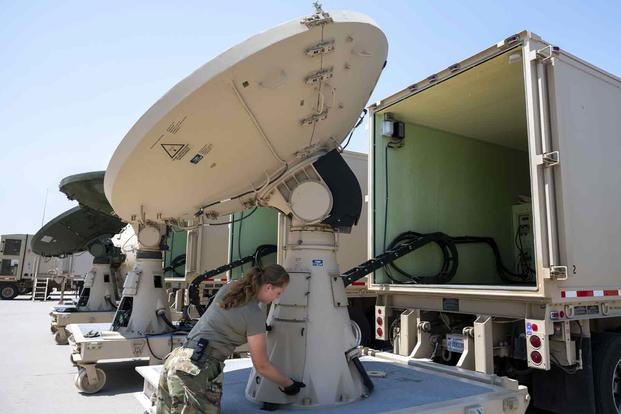The Space Force could soon have a Space National Guard -- as well as the addition of part-time Guardians -- if two different legislative proposals are approved by Congress.
The House's proposed defense authorization bill for the coming year aims to turn more than a dozen Air National Guard units into a Space National Guard. It's the third year that the move has been pushed forward in the annual policy bill, but the first time it has been included in the draft itself instead of being included as a separate amendment.
The draft legislation would also give the Space Force the option of a part-time, active-duty status for Guardians, replacing the conventional idea of a reserve force as a way to offer flexibility in serving. Getting it passed into law is one of the top priorities for the service.
Read Next: Enlisted Troops Could See 30% Pay Hike Under House's 2024 Defense Spending Bill
"It's the Space Force's No. 1 legislative proposal," said Maj. Tanya Downsworth, a Department of the Air Force spokesperson.
The two proposals are far from done deals. The mammoth, must-pass defense bill must still be approved and possibly amended by the full House, and then reconciled with the Senate's version before eventually becoming law. That's unlikely to happen before late fall or early winter.
The Space Guard plan has drawn opposition from critics who say the tiny service branch doesn't need the extra cost or logistical complications. President Joe Biden's White House has also opposed the idea.
Meanwhile, the Space Force has been pushing the part-time service idea. At the end of March, it submitted a report to Congress detailing how effective the idea would be -- a provision that was required in the last defense policy bill, which is called the National Defense Authorization Act, or NDAA.
The House's newly unveiled bill details a part-time service model for Guardians that allows an active-duty status, which would have drill requirements much like the usual reserve model.
"This proposal is a new model of service integrating active-component Guardians and Air Force reservists serving in space-focused career fields into a unified service that offers both full- and part-time billets," Downsworth said. "Our analysis showed that aligning and unifying mission execution and personnel development under the policy direction of the U.S. Space Force will enable the service to organize, train and equip in a more effective and efficient manner."
The House Armed Services personnel subcommittee advanced the legislation for both ideas on June 12, sending its approval to turn 14 Guard units of about 1,000 Air National Guardsmen into a new Space National Guard, as well as create a new part-time active-duty status.
While both provisions must still survive multiple steps, including Senate opposition, it's possible that both could be passed into law and used at the same time by the service.
"Those are realities that could coexist," Downsworth said.
Since the creation of the Space Force in late 2019, there have been attempts by defense advocates and lawmakers to establish a reserve or National Guard element for the smallest military service branch.
Those efforts have ultimately been stymied, as lawmakers grapple with the costs and logistics of creating another element of the National Guard.
The White House Office of Management and Budget issued a statement in 2021 saying it was strongly opposed to any efforts to create a Space Guard component, estimating it would increase costs each year by up to $500 million.
That figure has angered National Guard officials, and some outside observers believe the cost could be much less.
The Adjutants General Association of the United States sent a letter to the Senate Armed Services Committee last year saying that moving those 14 Air Force units under Space Force's command could cost as little as $250,000, with no need to create new facilities.
The part-time approach has been pitched by Secretary of the Air Force Frank Kendall in the past as his preferred solution rather than a Guard. Officials say the part-time model is the service's top focus and will help recruit top talent to the ranks.
Downsworth told Military.com that the service hopes to attract "people who are highly skilled" by offering flexibility to those with established careers.
The draft details three different statuses for Space Force Guardians: active, inactive and retired.
Under active status, Guardians can be on sustained duty or not on sustained duty. Sustained duty would be normal full-time, active-duty status.
Not on sustained duty, or part-time, means Guardians must "participate in at least 48 scheduled drills or training periods during each year and serve on active duty for not less than 14 days (exclusive of travel time) during each year; or serve on active duty for not more than 30 days during each year," according to the draft NDAA text.
Inactive status would be comparable to Individual Ready Reserve status in the Air Force, where a service member would not receive pay and would not drill unless called upon to do so, or if they volunteer to return to the active-duty force.
-- Thomas Novelly can be reached at thomas.novelly@military.com. Follow him on Twitter @TomNovelly.
Related: Creation of a Space National Guard Gets Renewed Push from Lawmakers













